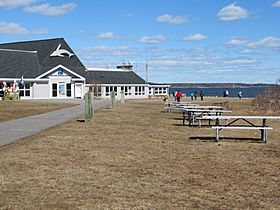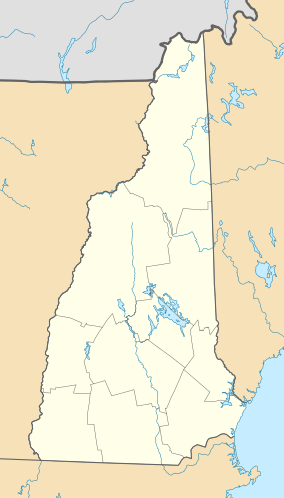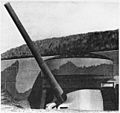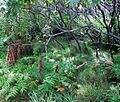Odiorne Point State Park facts for kids
Quick facts for kids Odiorne Point State Park |
|
|---|---|

The Seacoast Science Center
at Odiorne Point State Park |
|
| Location | Rye, Rockingham County, New Hampshire, United States |
| Area | 333.7 acres (135.0 ha) |
| Elevation | 10 feet (3.0 m) |
| Designation | New Hampshire state park |
| Established | 1961 (purchased); 1972 (opened) |
| Administrator | New Hampshire Division of Parks and Recreation |
| Website | Odiorne Point State Park |
Odiorne Point State Park is a cool public park right on the Atlantic Ocean in Rye, near Portsmouth. It's a great place to explore nature and history!
At the park, you can visit the Seacoast Science Center to learn about marine life. You can also see the old Fort Dearborn, which was a military base during World War II. The park is perfect for outdoor fun like hiking, biking, having picnics, fishing, and boating.
Contents
Park History: From Settlement to State Park
Odiorne Point has a long and interesting past. It's home to one of New Hampshire's Sunken Forests, which are ancient forests now covered by water. The area got its name from the Odiorne family, who settled here in the mid-1660s.
This spot is also famous as the site of the Pannaway Plantation. This was the very first European settlement in New Hampshire! There's a special memorial in the park to remember this important part of history.
Later, from 1942 to 1947, the park land was used for Fort Dearborn. In 1961, the United States government sold 137 acres of the fort to the State of New Hampshire. The deal was that the land had to be used for public recreation. After some work to add picnic areas and restrooms, Odiorne Point State Park officially opened in July 1972.
Seacoast Science Center: Explore Ocean Life
The Seacoast Science Center is a main attraction at Odiorne Point State Park. It's a fantastic place to learn all about the ocean and its creatures.
Inside, you'll find amazing aquariums filled with local marine animals. There are also touch tanks where you can gently feel some sea creatures. You can even see huge whale skeletons! The center also helps rescue marine mammals that are in trouble.
The Seacoast Science Center offers many programs for kids, families, and school groups. You can learn about marine life and how to protect our oceans. They even have environmental day camps for kids up to 8th grade.
Fort Dearborn: A World War II Story
Before 1942, the land where the park now sits was private, expensive oceanfront property. But during World War II, the United States government bought the land to build Fort Dearborn. This was part of a big plan to improve America's coastal defenses.
The fort was named after Henry Dearborn, who was a major general in the Revolutionary War. Fort Dearborn was an important part of the Harbor Defenses of Portsmouth, New Hampshire. It worked with other forts like Fort Stark, Fort Constitution, and Fort Foster to protect the harbor.
One of the first parts of Fort Dearborn was called Battery Dearborn. It had four large 155 mm guns placed on round concrete platforms. You can still see these platforms today!
The main reason Fort Dearborn was built was to house two huge 16-inch guns. These guns were protected by thick concrete and earth bunkers. They were finished and tested in 1944. This battery was first called Battery 103, but later named Battery Seaman. You can still see the remains of this battery today.
Another important part was Battery 204, which had two 6-inch guns. These guns were also protected by bunkers. This battery is near the Seacoast Science Center, and you can see some large 16-inch shells displayed there.
Smaller 90 mm guns were also placed nearby to defend against fast attack boats.
In 1948, Fort Dearborn was no longer needed, and all its guns were removed.
Images for kids
-
Juvenile humpback whale skeleton, inside the Seacoast Science Center
-
EDALHAB, an underwater habitat used for saturation diving experiments in Lake Winnipesaukee in the late 1960s, now located outside the Seacoast Science Center. Battery 204, a former 6-inch gun battery, is in the background.











